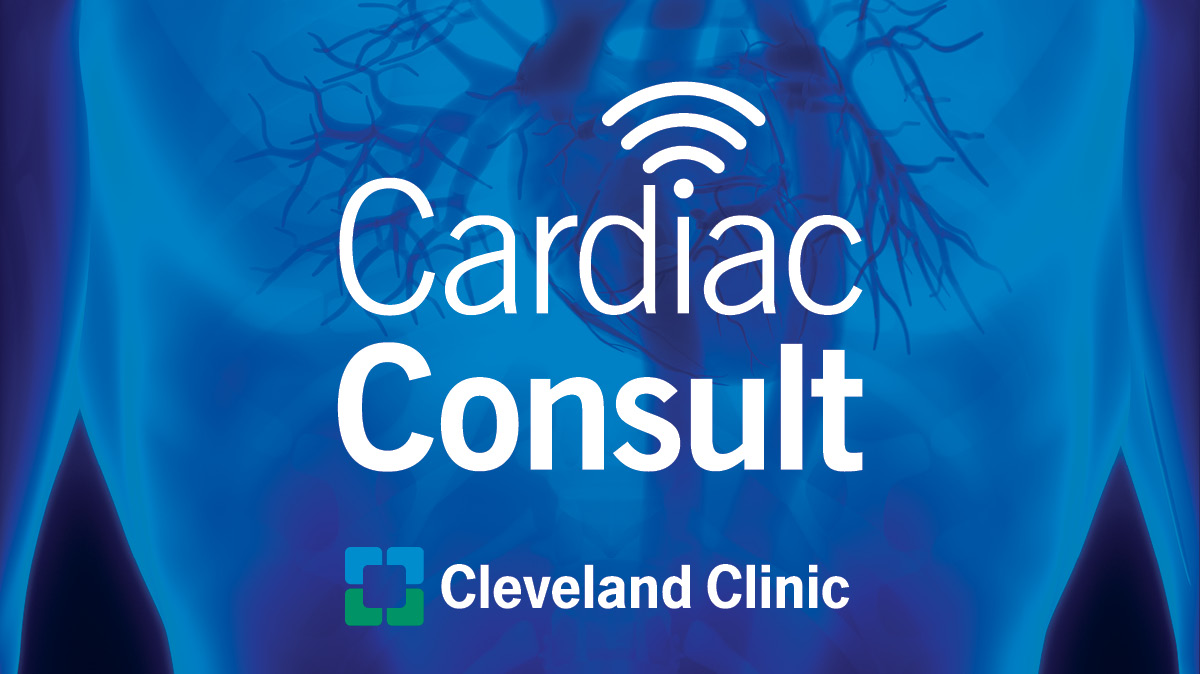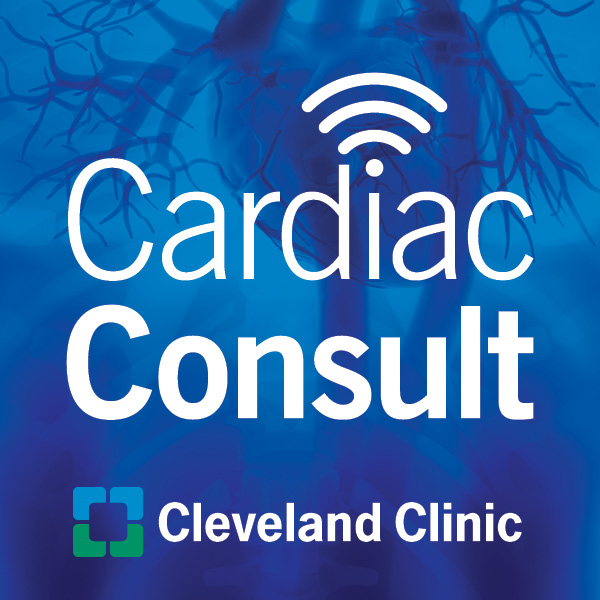Global EP Summit: Stroke Prevention in AFib

Walid Saliba, MD provides an overview of the PINNACLE and OPTION Trials.
Learn more about the Global EP Summit.
Subscribe: Apple Podcasts | Podcast Addict | Buzzsprout | Spotify
Global EP Summit: Stroke Prevention in AFib
Podcast Transcript
Announcer:
Welcome to Cleveland Clinic Cardiac Consult, brought to you by the Sydell and Arnold Miller Family Heart, Vascular and Thoracic Institute at Cleveland Clinic.
Walid Saliba, MD:
Good morning. I'm Walid Saliba, an electrophysiologist at the Cleveland Clinic, and I'm the Director of the Atrial Fibrillation Center. I would like to welcome you to the Global EP Summit. Over the next 15 minutes, I will talk about the new clinical trials, the PINNACLE FLX study as well as the OPTION trial, which is currently ongoing.
Walid Saliba, MD:
The Protect A-fib and the Prevail studies showed that left atrial appendage occlusion using the Watchman device when compared to warfarin is associated with a significant reduction in disabling strokes, a significant reduction in mortality that is primarily driven by a reduction in major bleeding events. The totality of the data led to the approval of the Watchman device by the FDA in 2015. The next generation Watchman FLX device is designed to advance procedural performance and safety while expanding the treatable population of patients with nonvalvular atrial fibrillation.
Walid Saliba, MD:
The Watchman FLX device, which was recently approved by the FDA in July of this year, is a little bit different than his older brother. To start with, it is 20 percent shallower and comes with a larger size and therefore it can tackle some of the challenging anatomies that we encountered with the older device, such as appendages that are shallow or have fairly large ostia. In addition, the new frame has a greater number of struts allowing more contact points for a better seal. It has a closed distal end to minimize appendage trauma and allow advancement within the left atrial appendage. It has dual row anchors to increase device engagement in the tissue and therefore better stability. It allows full recapture and repositioning of the device, therefore minimizing the use of extra devices, and also it has a reduced metal exposure and increased span of the fabric to minimize thrombogenicity. This has allowed to safely enter and maneuver within the left atrial appendage while providing a safer and more effective seal.
Walid Saliba, MD:
The PINNACLE study was designed to establish the safety and effectiveness of the Watchman FLX in patients with nonvalvular atrial fibrillation to reduce the risk of stroke. It is a single arm, prospective, non-randomized, US-only IDE study that evaluated the safety and effectiveness of the Watchman FLX device. It is important to note that DOAC was the only option for post-implant drug regimen, not warfarin, which was used in the PROTECT and the PREVAIL studies. The goal is non-inferiority to performance goal based on the current generation Watchman, which is data derived from currently available Watchman trials.
Walid Saliba, MD:
400 patients at 29 US sites were enrolled. The enrollment was fairly rapid. And as you can see here, the post-procedural antithrombotic regimen included the DOAC plus aspirin for 45 days post-implant followed by clopidogrel plus aspirin through six months, and then aspirin indefinitely. TEE was performed at 45 days and again at one year.
Walid Saliba, MD:
The study endpoints included primary safety and primary efficacy endpoint. The primary safety endpoint really looking at issues related to the procedure itself, so therefore this includes any of the following occurring within seven days following the procedure or until the time of discharge. This included all causes of death, ischemic stroke, systemic embolism, device or procedure related events requiring open cardiac surgery or major endovascular intervention.
Walid Saliba, MD:
The primary efficacy endpoint really looks at the adequacy of closure and seal of the device at one year, so the rate of effective left atrial appendage closure defined as any peri device flow less than five millimeters demonstrated by TEE at 12 months. And also there is a secondary efficacy endpoint, which is now being collected, which includes the occurrence of ischemic stroke or systemic embolism at 24 months from the time of enrollments.
Walid Saliba, MD:
These are the baseline demographics. As you can see, this is a high risk patient population with a min CHA₂DS₂-VASc score of 4.2. Twenty-two percent of them had prior history of stroke, and a third of these patients had a prior history of major bleeding or predisposition to bleeding.
Walid Saliba, MD:
The implant was successful in almost 99 percent of the cases. Only five of the 400 were not implanted. On the average, 1.2 devices were required per case, which is lower than the prior older generation Watchman device, and the implant success is consistent if not better compared to the prior Watchman studies.
Walid Saliba, MD:
The primary effectiveness endpoint, which is the rate of effective LAA closure at one year was achieved in all patients, which is superior to the preset performance goal of 97 percent. Now, if you look at the detailed LAA closure assessment, a complete seal at 12 months was achieved in almost 90 percent of the patients, which is definitely better than what we had in PROTECT AF and PREVAIL, which was around 67 percent at 12 months follow up.
Walid Saliba, MD:
The primary safety endpoint, which as we mentioned, the occurrence of any one of these events between the time of implant and within seven days following the procedure, occurred in only two patients, or 0.5 percent, which is significantly better compared to the preset performance goal of 4.2 percent. These two events include ischemic strokes in two patients. One patient had an ischemic stroke one day after an unsuccessful procedure with new visual field deficit. The second patient had an ischemic stroke two days after the procedure and had minimal residual symptoms by the time of discharge.
Walid Saliba, MD:
As we said, DOAC were used immediately after implant, mainly apixaban and rivaroxaban, which were used in 98 percent of the patients. Nearly all patients, 96 percent, were able to discontinue their oral anticoagulation at 45 days after the TEE showed that there is adequate closure of the left atrial appendage. One percent continued their anticoagulation because of inadequate seal. This is quite comparable, if not better to the prior Watchman trials. In terms of oral anticoagulation discontinuation rate.
Walid Saliba, MD:
This is the 12 month adjudicated major clinical event. Again, this is not the 24 month secondary endpoint of stroke and thromboembolism. That data is currently being collected. As you can see, there were no hemorrhagic stroke, 2.6 percent had ischemic stroke. There were no device embolization and there were four pericardial effusions that required percutaneous evacuation, not surgical, but only percutaneous evacuation.
Walid Saliba, MD:
If you look at the timing of the pericardial effusion, one occurred very, very late at the time of an A-fib ablation, but the other three occurred beyond the seven day post implant and before the 45 day TEE. Kind of a delayed diffusion and required pericardial synthesis for evacuation.
Walid Saliba, MD:
If you look at the timing of the ischemic stroke and you take away the first two patients who had immediately post-procedural ischemic stroke, you can see that most of the ischemic strokes occurred beyond the 45 days post TEE. Device related thrombus occurred in seven patients or 1.8 percent, all of whom were on dual antiplatelet therapy or aspirin at the time of detection. Two of these patients developed ischemic stroke or systemic embolism.
Walid Saliba, MD:
So in summary, the PINNACLE FLX study showed that the Watchman FLX in combination with the six week post-procedural regimen of DOAC and low-dose aspirin is associated with the low rate of safety events and the high rate of effective appendage closure. The PINNACLE FLX met the primary safety endpoint with 0.5 percent experiencing an event, met the primary effectiveness endpoint with 100 percent adequate closure, and follow up is ongoing until all patients reach the 24-month window whereby the secondary effectiveness endpoints will be reported.
Walid Saliba, MD:
Now I want to spend few minutes talking about the ongoing OPTION clinical trial. The primary objective of the OPTION trial is to determine if left atrial appendage closure with the Watchman FLX device is a reasonable alternative to oral anticoagulation following catheter ablation for high risk patients with non valvular atrial fibrillation.
Walid Saliba, MD:
What is the rationale for the OPTION trial? While we currently know that patients who undergo atrial fibrillation ablation, if they are at high risk of stroke based on their CHA₂DS₂-VASc risk, they have to continue oral anticoagulation. And the reasoning behind that is that afib ablation is not a cure. A-fib is not gone, actually, you just have to look harder or longer and you might see some recurrence. The recurrences were more likely to be asymptomatic after an ablation compared to before the ablation. And there is a false sense of security that atrial fibrillation is gone after an ablation and therefore I can stop oral anticoagulation, and this happened in almost 20 percent of patients despite their high CHA₂DS₂-VASc score.
Walid Saliba, MD:
Furthermore, we do not have any randomized clinical trial that evaluated the safety of discontinuation of oral anticoagulation in post ablation patients. So the big question, can patients get off oral anticoagulation following a perceived successful ablation? Current guidelines recommend that oral anticoagulation should be continued after ablation in patients at high risk of stroke based on their CHA₂DS₂-VASc score.
Walid Saliba, MD:
And more importantly, we have to understand the model, that there's a disconnect between atrial fibrillation event and the occurrence of stroke. And the old dictum that you have to have atrial fibrillation to have a stroke in the setting of a high CHA₂DS₂-VASc might not be totally true because the concept of an atrial myopathy that predisposes to atrial fibrillation as well as concomitantly predisposes to stroke is now gaining more and more traction to the point that stroke and atrial fibrillation are two phenotypes of the same disease.
Walid Saliba, MD:
The OPTION trial will enroll 1600 patients in 130 global sites. These patients have nonvalvular atrial fibrillation at high risk of stroke by virtue of a CHA₂DS₂-VASc score of greater than two in men, greater than three in women. And these patients either have undergone atrial fibrillation ablation recently or are planning to have an A-fib ablation. These will be randomized to either A-fib ablation plus oral anticoagulation, which is the standard of care and what we do currently, or A-fib ablation together with the Watchman FLX device followed by a short term oral anticoagulation similar to the previous trial but a slightly different regimen.
Walid Saliba, MD:
Now the placement of the Watchman FLX can be either concomitant at the time of the ablation or it can be sequential, which means three to six months following an ablation that was done prior and now the patient is following up on his first visit post his ablation, and you can discuss with him the possibility of maybe enrolling in the study and getting off oral anticoagulation with a 50/50 chance.
Walid Saliba, MD:
The medication regimen following device implantation includes three months of DOAC plus aspirin. Again, this is DOAC, not Warfarin. This is followed by three to 12 months of aspirin alone. There's no Plavix involved here. And more than 12 months aspirin is recommended. The co-primary endpoints include death, stroke, and systemic embolization, and they are seeking the non-inferiority measure here and the major non-procedural bleeding.
Walid Saliba, MD:
As I said, in the device arm, the implant can be done concomitant or sequential. Concomitant meaning that the subject is consented prior to the ablation and the Watchman FLX device is actually implanted at the time of the ablation right after the ablation. They occur on the same day. And the sequential, the ablation occurs prior to the consent. This is a patient who has had an ablation, but within three to six months from that ablation, the subject is randomized and the device is implanted if the subject is randomized to devised implantation.
Walid Saliba, MD:
And the idea of a combined A-fib ablation and left atrial appendage occlusion is not new. There are several reports in the literature that actually showed that such an approach is highly successful, has low complications and has resulted in a good seal of the Watchman device in the left atrial appendage.
And we will hear about some of the benefits of a combined approach from Dr. Kanj later on. Most importantly, it is probably more efficient, lower cost. You are already in the left atrium at the time of the ablation, so you're in the same zip code. You might as well put the Watchman device since you're there. It's definitely better accepted by patients. There are some issues about sizing and stability that you will hear about, but in our experience, this has not been an issue.
Walid Saliba, MD:
To date the enrollment is 505 out of 1600. As you can see, predominantly in North America, 40 percent of the patients were in the concomitant and 60 percent in the sequential group. Therefore, I would say 20 percent of the patients have had a combined Watchmen and A-fib ablation procedure. And if you look at the demographics just very quickly, similar to the previous trials of the Watchmen, average age 70. 66 percent male. Lower risk group with a CHA₂DS₂-VASc of 3.7 and a HAS-BLED of 1.3. Which is not surprising because continuation of oral anticoagulation is a must for this study. And obviously if the result of the option are positive, then this will provide the label expansion to include these high risk patients who are undergoing A-fib ablation.
Walid Saliba, MD:
So these are the three major trials that involves the newer Watchman FLX device, the PINNACLE FLX that we've talked about which is completed the OPTION trial, which is ongoing, and we'll hear shortly after about the CHAMPION A-fib study that we are all excited about. Thank you very much.
Announcer:
Thank you for listening. We hope you enjoyed the podcast. We welcome your comments and feedback. Please contact us at heart@ccf.org. Like what you heard? Subscribe wherever you get your podcasts or listen at clevelandclinic.org/CardiacConsultPodcast.

Cardiac Consult
A Cleveland Clinic podcast exploring heart, vascular and thoracic topics of interest to healthcare providers: medical and surgical treatments, diagnostic testing, medical conditions, and research, technology and practice issues.



